Clinical Diagnosis and Laboratory Testing of Abnormal Appearing Toenails: A Retrospective Assessment of Confirmatory Testing for Onychomycosis in the United States, 2022–2023
Abstract
1. Introduction
2. Materials and Methods
2.1. Fungal Culture
2.2. Histopathology
2.3. Multiplex Real-Time PCR
2.4. Data Analysis
3. Results
3.1. Geographical Distribution of Abnormal Appearing Toenails Submitted for Confirmatory Testing of Onychomycosis
3.2. Confirmatory Testing per Utilization of Fungal Culture, Histopathology, PCR or Combination
3.3. Confirmatory Testing in Different Age Groups
3.4. Distribution of Fungi Groups in PCR-Positive Samples with or without Corroboration by Histopathology
3.5. Confirmatory Testing and Fungi Detection/Identification Pattern in Male and Female Onychomycosis Patients
3.6. Confirmatory Testing in Clinically Apparent Onychomycosis with Co-Diagnoses
4. Discussion
5. Conclusions
Author Contributions
Funding
Institutional Review Board Statement
Informed Consent Statement
Data Availability Statement
Conflicts of Interest
References
- Scher, R.K.; Baran, R. Onychomycosis in Clinical Practice: Factors Contributing to Recurrence. Br. J. Dermatol. 2003, 149, 5–9. [Google Scholar] [CrossRef] [PubMed]
- Sigurgeirsson, B.; Baran, R. The Prevalence of Onychomycosis in the Global Population: A Literature Study. J. Eur. Acad. Dermatol. Venereol. 2014, 28, 1480–1491. [Google Scholar] [CrossRef] [PubMed]
- Gupta, A.K.; Jain, H.C.; Lynde, C.W.; Macdonald, P.; Cooper, E.A.; Summerbell, R.C. Prevalence and Epidemiology of Onychomycosis in Patients Visiting Physicians’ Offices: A Multicenter Canadian Survey of 15,000 Patients. J. Am. Acad. Dermatol. 2000, 43, 244–248. [Google Scholar] [CrossRef] [PubMed]
- Ghannoum, M.A.; Hajjeh, R.A.; Scher, R.; Konnikov, N.; Gupta, A.K.; Summerbell, R.; Sullivan, S.; Daniel, R.; Krusinski, P.; Fleckman, P.; et al. A Large-Scale North American Study of Fungal Isolates from Nails: The Frequency of Onychomycosis, Fungal Distribution, and Antifungal Susceptibility Patterns. J. Am. Acad. Dermatol. 2000, 43, 641–648. [Google Scholar] [CrossRef] [PubMed]
- Elewski, B.E.; Charif, M.A. Prevalence of Onychomycosis in Patients Attending a Dermatology Clinic in Northeastern Ohio for Other Conditions. Arch. Dermatol. 1997, 133, 1172–1173. [Google Scholar] [CrossRef] [PubMed]
- Ioannidou, D.J.; Maraki, S.; Krasagakis, S.K.; Tosca, A.; Tselentis, Y. The Epidemiology of Onychomycoses in Crete, Greece, between 1992 and 2001. J. Eur. Acad. Dermatol. Venereol. 2006, 20, 170–174. [Google Scholar] [CrossRef]
- Sigurgeirsson, B.; Steingrímsson, O.; Sveinsdóttir, S. Prevalence of Onychomycosis in Iceland: A Population-Based Study. Acta Derm. Venereol. 2002, 82, 467–469. [Google Scholar] [CrossRef] [PubMed]
- Svejgaard, E.L.; Nilsson, J. Onychomycosis in Denmark: Prevalence of Fungal Nail Infection in General Practice. Mycoses 2004, 47, 131–135. [Google Scholar] [CrossRef]
- Elewski, B.E. Onychomycosis. Treatment, Quality of Life, and Economic Issues. Am. J. Clin. Dermatol. 2000, 1, 19–26. [Google Scholar] [CrossRef]
- Scher, R.K. Onychomycosis Is More than a Cosmetic Problem. Br. J. Dermatol. 1994, 130, 15. [Google Scholar] [CrossRef]
- Baran, R.; McLoone, N.; Hay, R.J. Could Proximal White Subungual Onychomycosis Be a Complication of Systemic Spread? The Lessons to Be Learned from Maladie Dermatophytique and Other Deep Infections. Br. J. Dermatol. 2005, 153, 1023–1025. [Google Scholar] [CrossRef]
- Si, H.; Li, Y.; Huang, Z.; Cui, Y.; Li, S. Erythroderma Combined with Deeper Dermal Dermatophytosis due to Trichophyton rubrum in a Patient with Myasthenia Gravis: First Case Report and Literature Review. BMC Infect. Dis. 2023, 23, 789. [Google Scholar] [CrossRef]
- Gold, J.A.W.; Wu, K.; Jackson, B.R.; Benedict, K. Opportunities to Improve Guideline Adherence for the Diagnosis and Treatment of Onychomycosis: Analysis of Commercial Insurance Claims Data, United States. J. Am. Acad. Dermatol. 2023, 88, 683–686. [Google Scholar] [CrossRef]
- Peck, G.M.; Fleischer, A.B.; Lipner, S.R. Onychomycosis Treatment Prescribed at Only Twenty Percent of Visits: A Cross-Sectional Analysis of the National Ambulatory Medical Care Survey 2007 to 2016. J. Drugs Dermatol. 2023, 22, 1040–1045. [Google Scholar] [CrossRef] [PubMed]
- Benedict, K.; Gold, J.A.W.; Wu, K.; Lipner, S.R. High Frequency of Self-Diagnosis and Self-Treatment in a Nationally Representative Survey about Superficial Fungal Infections in Adults-United States, 2022. J. Fungi 2022, 9, 19. [Google Scholar] [CrossRef]
- Watjer, R.M.; Bonten, T.N.; Arkesteijn, M.A.; Quint, K.D.; van der Beek, M.T.; van der Raaij-Helmer, L.M.; Numans, M.E.; Eekhof, J.A. The Accuracy of Clinical Diagnosis of Onychomycosis in Dutch General Practice: A Diagnostic Accuracy Study. BJGP Open 2023, 7, BJGPO.2022.0186. [Google Scholar] [CrossRef] [PubMed]
- Lindsø Andersen, P.; Jørgensen, I.F.; Saunte, D.M.L.; Jemec, G.B.; Pedersen, O.B.; Brunak, S. An Increase in Specialist Treatment for Onychomycosis: An Unexplained Tendency. A Retrospective Study of Patients Treated for Onychomycosis in Danish Hospitals from 1994 to 2018. J. Fungi 2023, 9, 33. [Google Scholar] [CrossRef] [PubMed]
- Elloumi-Jellouli, A.; Triki, S.; Driss, M.; Derbel, F.; Zghal, M.; Mrad, K.; Rhomdhnane, K. Ben A Misdiagnosed Nail Bed Melanoma. Dermatol. Online J. 2010, 16, 13. [Google Scholar] [PubMed]
- Riahi, R.R.; Cohen, P.R.; Goldberg, L.H. Subungual Amelanotic Melanoma Masquerading as Onychomycosis. Cureus 2018, 10, e2307. [Google Scholar] [CrossRef] [PubMed]
- Tosti, A.; Hay, R.; Arenas-Guzmán, R. Patients at Risk of Onychomycosis—Risk Factor Identification and Active Prevention. J. Eur. Acad. Dermatol. Venereol. 2005, 19 (Suppl. S1), 13–16. [Google Scholar] [CrossRef] [PubMed]
- Nenoff, P.; Reinel, D.; Mayser, P.; Abeck, D.; Bezold, G.; Bosshard, P.P.; Brasch, J.; Daeschlein, G.; Effendy, I.; Ginter-Hanselmayer, G.; et al. S1 Guideline Onychomycosis. J. Dtsch. Dermatol. Ges. 2023, 21, 678–692. [Google Scholar] [CrossRef]
- Lipner, S.R.; Scher, R.K. Onychomycosis: Clinical Overview and Diagnosis. J. Am. Acad. Dermatol. 2019, 80, 835–851. [Google Scholar] [CrossRef]
- Lim, S.S.; Ohn, J.; Mun, J.-H. Diagnosis of Onychomycosis: From Conventional Techniques and Dermoscopy to Artificial Intelligence. Front. Med. 2021, 8, 637216. [Google Scholar] [CrossRef]
- Gupta, A.K.; Cooper, E.A.; Wang, T.; Lincoln, S.A.; Bakotic, W.L. Single-Point Nail Sampling to Diagnose Onychomycosis Caused by Non-Dermatophyte Molds: Utility of Polymerase Chain Reaction (PCR) and Histopathology. J. Fungi 2023, 9, 671. [Google Scholar] [CrossRef]
- Altman, D.G.; Bland, J.M. How to Obtain the P Value from a Confidence Interval. BMJ 2011, 343, d2304. [Google Scholar] [CrossRef] [PubMed]
- Summerbell, R.C. Epidemiology and Ecology of Onychomycosis. Dermatology 1997, 194, 32–36. [Google Scholar] [CrossRef]
- Gupta, A.K.; Drummond-Main, C.; Cooper, E.A.; Brintnell, W.; Piraccini, B.M.; Tosti, A. Systematic Review of Nondermatophyte Mold Onychomycosis: Diagnosis, Clinical Types, Epidemiology, and Treatment. J. Am. Acad. Dermatol. 2012, 66, 494–502. [Google Scholar] [CrossRef]
- Trovato, L.; Domina, M.; Calvo, M.; De Pasquale, R.; Scalia, G.; Oliveri, S. Use of Real Time Multiplex PCR for the Diagnosis of Dermatophytes Onychomycosis in Patients with Empirical Antifungal Treatments. J. Infect. Public Health 2022, 15, 539–544. [Google Scholar] [CrossRef] [PubMed]
- Hwang, J.K.; Bakotic, W.L.; Gold, J.A.W.; Magro, C.M.; Lipner, S.R. Isolation of Terbinafine-Resistant Trichophyton rubrum from Onychomycosis Patients Who Failed Treatment at an Academic Center in New York, United States. J. Fungi 2023, 9, 710. [Google Scholar] [CrossRef]
- Guarner, J.; Brandt, M.E. Histopathologic Diagnosis of Fungal Infections in the 21st Century. Clin. Microbiol. Rev. 2011, 24, 247–280. [Google Scholar] [CrossRef] [PubMed]
- Araya, S.; Abuye, M.; Negesso, A.E. Epidemiological Characterization of Dermatomycosis in Ethiopia. Clin. Cosmet. Investig. Dermatol. 2021, 14, 83–89. [Google Scholar] [CrossRef] [PubMed]
- Akpinar Kara, Y. The Change of Causative Pathogens in Toenail Onychomycosis. J. Cosmet. Dermatol. 2021, 20, 2311–2316. [Google Scholar] [CrossRef]
- Hirose, M.; Noguchi, H.; Yaguchi, T.; Matsumoto, T.; Hiruma, M.; Fukushima, S.; Ihn, H. Onychomycosis Caused by Aspergillus subramanianii. J. Dermatol. 2018, 45, 1362–1366. [Google Scholar] [CrossRef]
- Takahata, Y.; Hiruma, M.; Sugita, T.; Muto, M. A Case of Onychomycosis due to Aspergillus sydowii Diagnosed Using DNA Sequence Analysis. Mycoses 2008, 51, 170–173. [Google Scholar] [CrossRef]
- Brasch, J.; Varga, J.; Jensen, J.-M.; Egberts, F.; Tintelnot, K. Nail Infection by Aspergillus ochraceopetaliformis. Med. Mycol. 2009, 47, 658–662. [Google Scholar] [CrossRef] [PubMed]
- Martínez-Herrera, E.O.; Arroyo-Camarena, S.; Tejada-García, D.L.; Porras-López, C.F.; Arenas, R. Onychomycosis due to Opportunistic Molds. An. Bras. Dermatol. 2015, 90, 334–337. [Google Scholar] [CrossRef] [PubMed]
- Segal, R.; Shemer, A.; Hochberg, M.; Keness, Y.; Shvarzman, R.; Mandelblat, M.; Frenkel, M.; Segal, E. Onychomycosis in Israel: Epidemiological Aspects. Mycoses 2015, 58, 133–139. [Google Scholar] [CrossRef]
- Veraldi, S.; Chiaratti, A.; Harak, H. Onychomycosis Caused by Aspergillus versicolor. Mycoses 2010, 53, 363–365. [Google Scholar] [CrossRef]
- Sigurgeirsson, B.; Steingrímsson, O. Risk Factors Associated with Onychomycosis. J. Eur. Acad. Dermatol. Venereol. 2004, 18, 48–51. [Google Scholar] [CrossRef]
- Walling, H.W.; Sniezek, P.J. Distribution of Toenail Dystrophy Predicts Histologic Diagnosis of Onychomycosis. J. Am. Acad. Dermatol. 2007, 56, 945–948. [Google Scholar] [CrossRef]
- Benedict, K.; Lipner, S.R.; Lockhart, S.R.; Gold, J.A.W. Low Positivity Rate and High Percentage of Nondermatophyte Molds in an Analysis of 35,257 Fungal Nail Culture Results from a United States National Commercial Laboratory, 2019–2022. JAAD Int. 2023, 12, 43–45. [Google Scholar] [CrossRef] [PubMed]

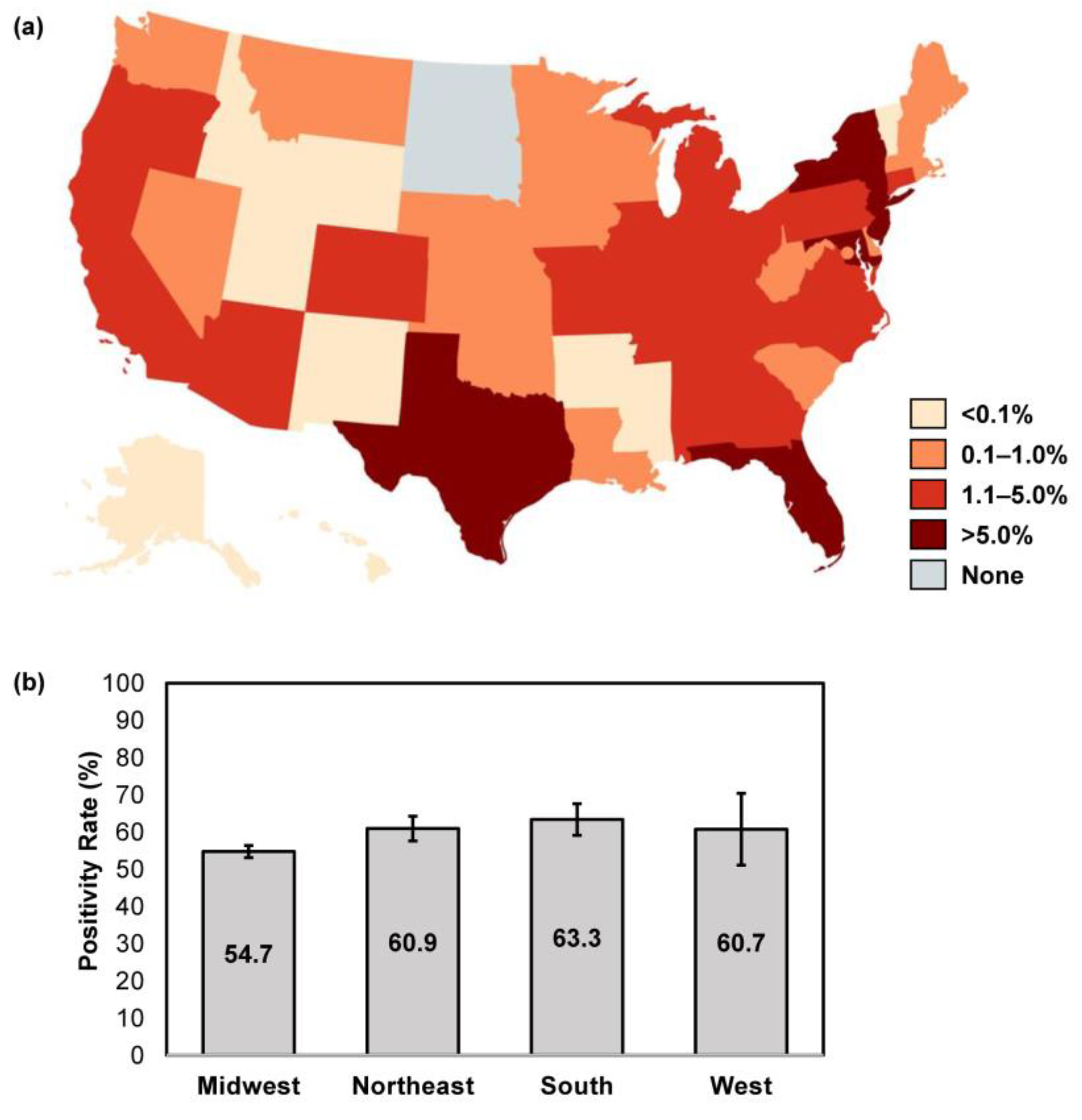
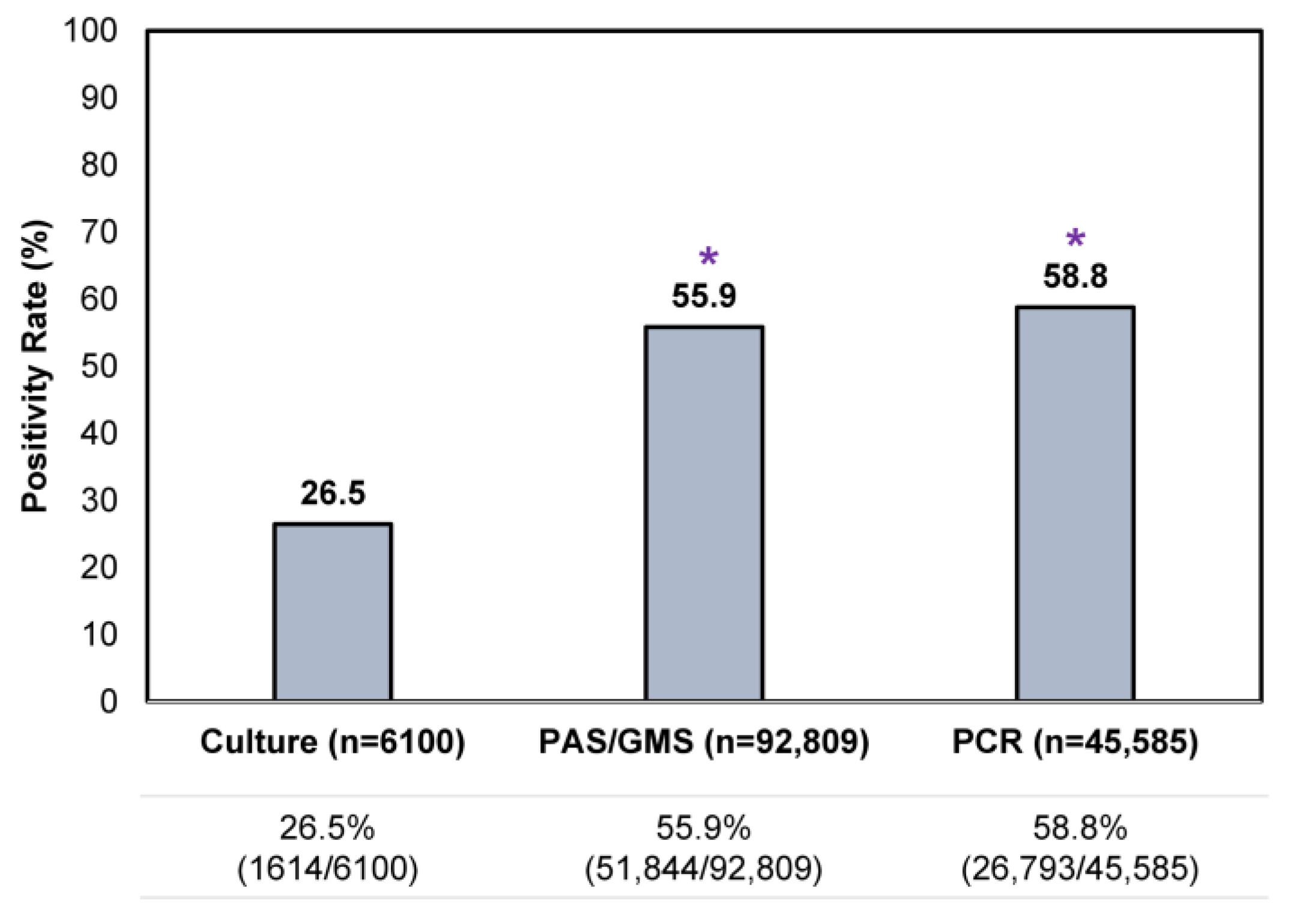
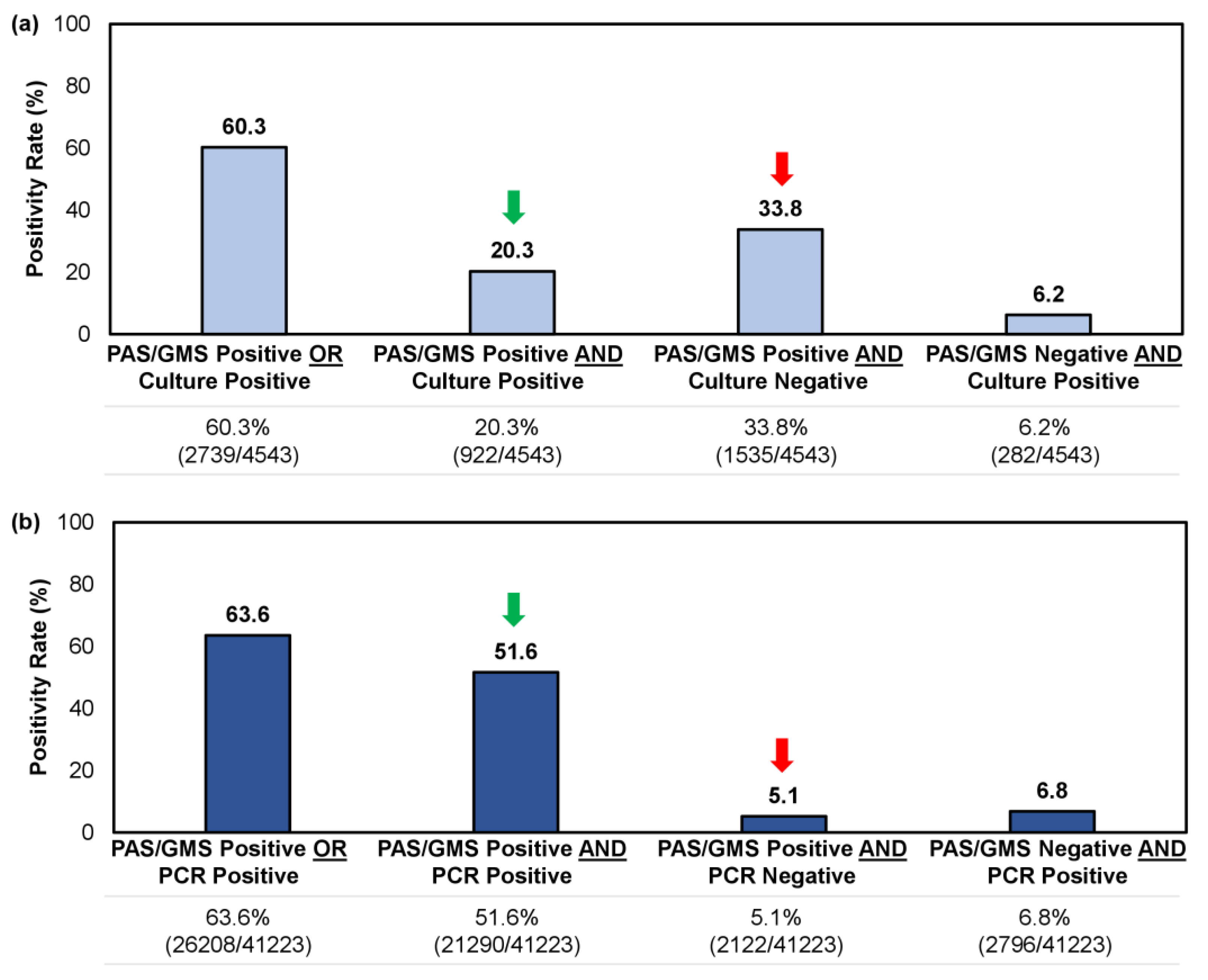
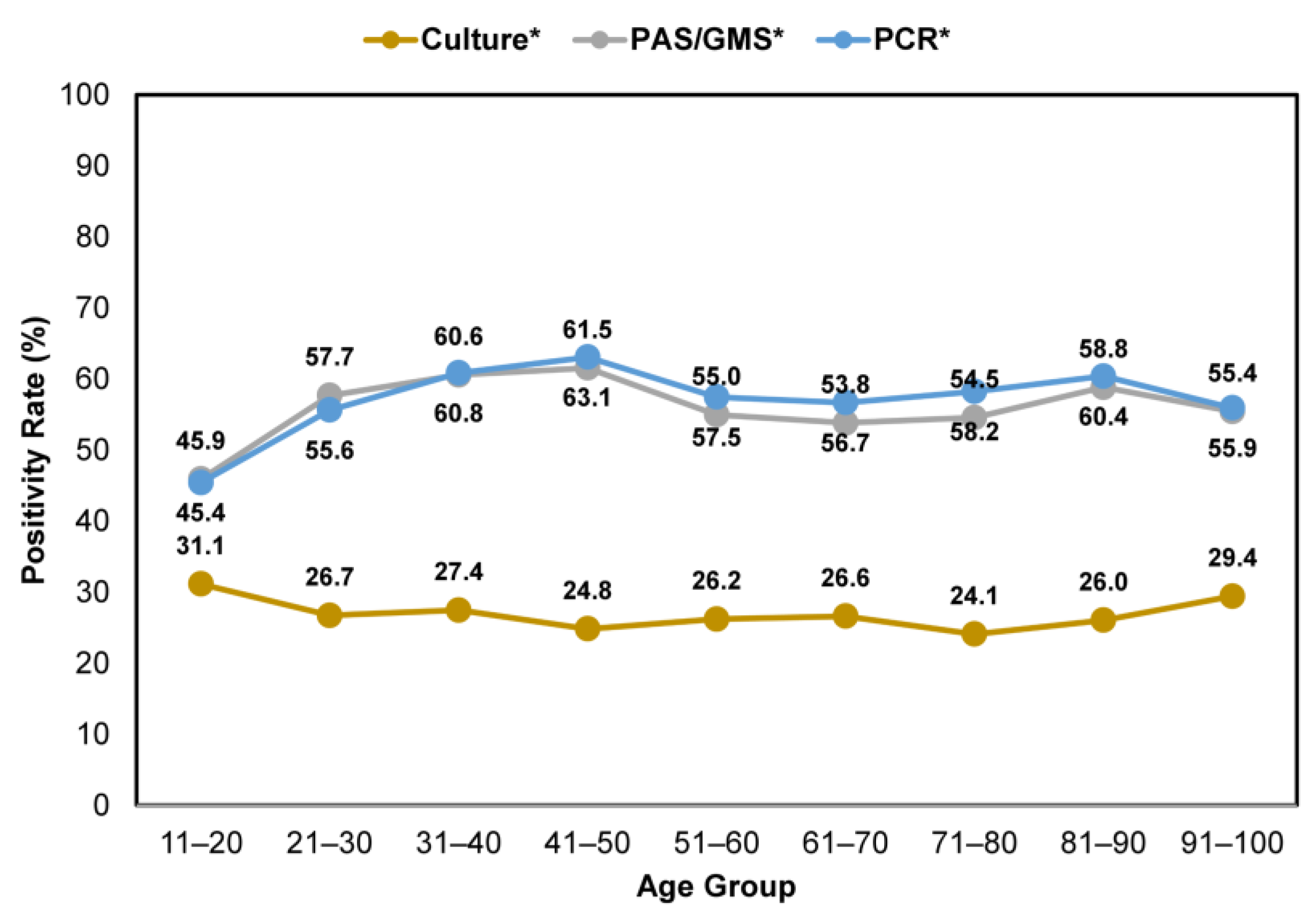

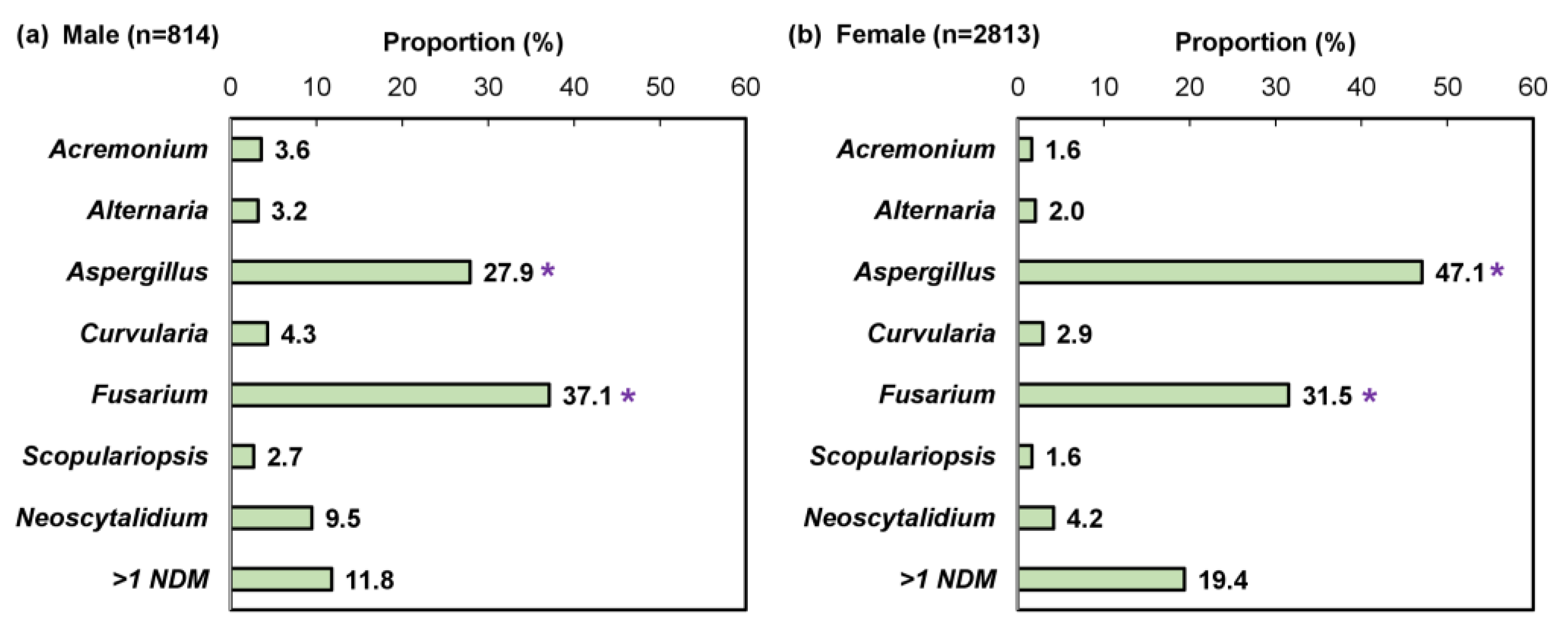
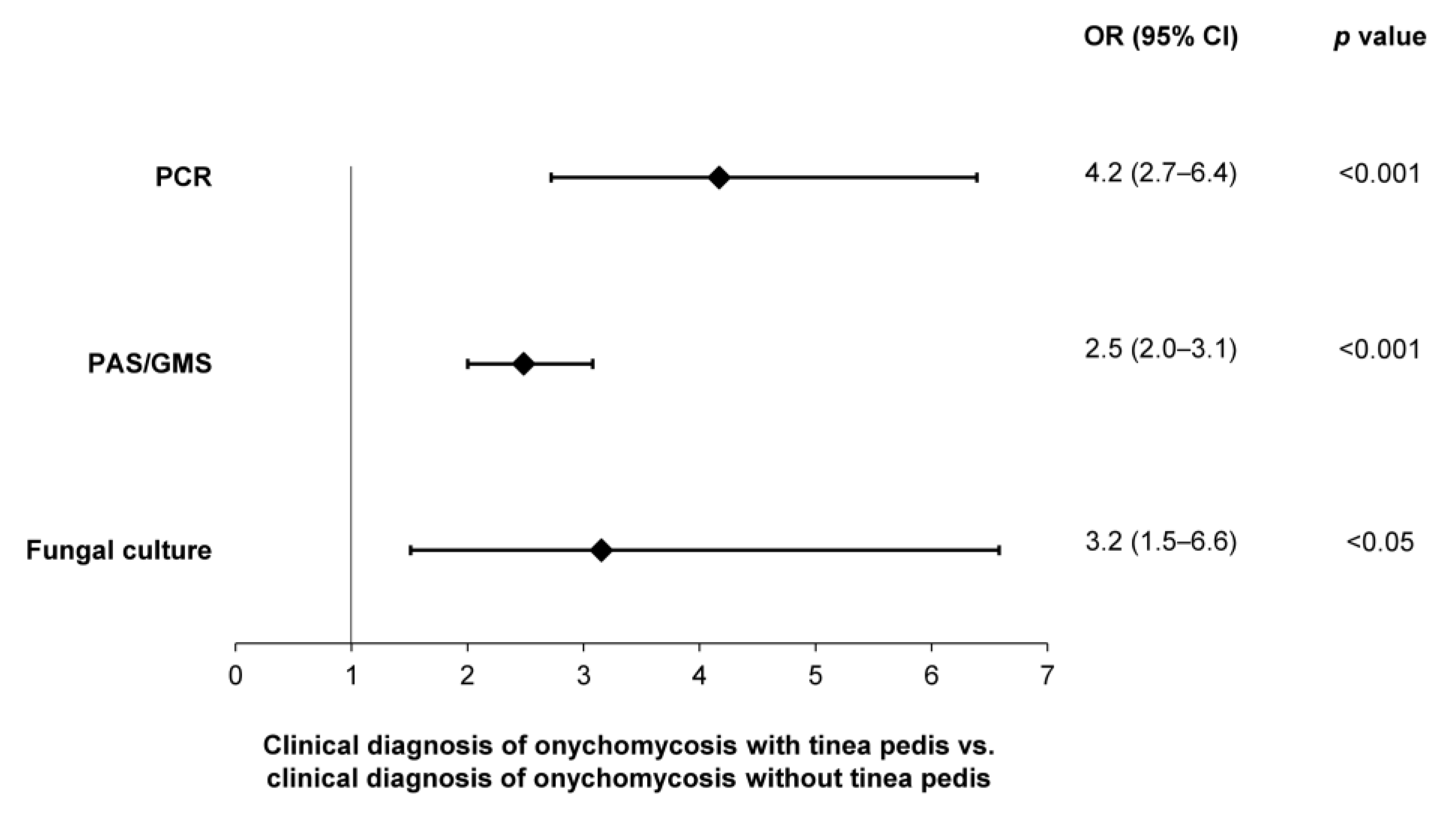
Disclaimer/Publisher’s Note: The statements, opinions and data contained in all publications are solely those of the individual author(s) and contributor(s) and not of MDPI and/or the editor(s). MDPI and/or the editor(s) disclaim responsibility for any injury to people or property resulting from any ideas, methods, instructions or products referred to in the content. |
© 2024 by the authors. Licensee MDPI, Basel, Switzerland. This article is an open access article distributed under the terms and conditions of the Creative Commons Attribution (CC BY) license (https://creativecommons.org/licenses/by/4.0/).
Share and Cite
Gupta, A.K.; Wang, T.; Cooper, E.A.; Lincoln, S.A.; Foreman, H.-C.; Scherer, W.P.; Bakotic, W.L. Clinical Diagnosis and Laboratory Testing of Abnormal Appearing Toenails: A Retrospective Assessment of Confirmatory Testing for Onychomycosis in the United States, 2022–2023. J. Fungi 2024, 10, 149. https://doi.org/10.3390/jof10020149
Gupta AK, Wang T, Cooper EA, Lincoln SA, Foreman H-C, Scherer WP, Bakotic WL. Clinical Diagnosis and Laboratory Testing of Abnormal Appearing Toenails: A Retrospective Assessment of Confirmatory Testing for Onychomycosis in the United States, 2022–2023. Journal of Fungi. 2024; 10(2):149. https://doi.org/10.3390/jof10020149
Chicago/Turabian StyleGupta, Aditya K., Tong Wang, Elizabeth A. Cooper, Sara A. Lincoln, Hui-Chen Foreman, William P. Scherer, and Wayne L. Bakotic. 2024. "Clinical Diagnosis and Laboratory Testing of Abnormal Appearing Toenails: A Retrospective Assessment of Confirmatory Testing for Onychomycosis in the United States, 2022–2023" Journal of Fungi 10, no. 2: 149. https://doi.org/10.3390/jof10020149
APA StyleGupta, A. K., Wang, T., Cooper, E. A., Lincoln, S. A., Foreman, H.-C., Scherer, W. P., & Bakotic, W. L. (2024). Clinical Diagnosis and Laboratory Testing of Abnormal Appearing Toenails: A Retrospective Assessment of Confirmatory Testing for Onychomycosis in the United States, 2022–2023. Journal of Fungi, 10(2), 149. https://doi.org/10.3390/jof10020149






